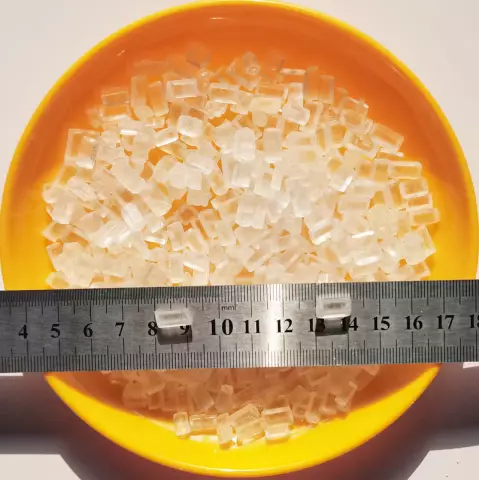- Author Rachel Wainwright [email protected].
- Public 2023-12-15 07:39.
- Last modified 2025-11-02 20:14.
Sodium nitrate

Sodium nitrate is also known as sodium or Chilean nitrate. It has the chemical formula NaNO 3 and in purified form is white, grayish or slightly yellowish powder crystals. Externally and in taste, sodium nitrate resembles ordinary table salt and dissolves well in water. In nature, this compound can be found in its natural form - such a natural mineral is common in Chile.
Sodium nitrate: creepy or cute
In most cases, the production of sodium nitrate is based on the synthesis of a crystalline substance from nitrogen in air or ammonia. Other technologies for obtaining sodium nitrate are various decomposition reactions or interactions of substances. For example, it is possible to obtain sodium nitrate by leaching from natural deposits with hot water, crystallization, absorption of nitrogen oxides with a solution of soda, decomposition of ammonium or calcium nitrate and subsequent exchange with carbonate, sulfate or sodium chloride.
Sodium nitrate is widely used in industrial production in the manufacture of stainless steel pipes, glass, the production of refrigerants and rocket fuel, and is also successfully used in agriculture, medicine and the food industry. Medicines containing sodium nitrate are prescribed as bronchodilators, laxatives, intestinal cramps, and cyanide antidotes.
In the production of food products, more often sausages and cheeses, sodium nitrate acts as a dye and preservative that prevents the spread of the causative agent of a deadly disease - botulism; as a food additive, it is designated as E251. At the same time, the substance in large doses is extremely toxic to mammals, and when heated - by heat treatment of products - it has a proven carcinogenic activity.
For a person, the highest daily dose of sodium nitrate is 3.7 mg of a substance per 1 kg of body weight, while taking into account not the sodium, but the nitrogen component. So, with a body weight of 70 kg, 259 mg of E251 for the nitrogen group of NO 3 will correspond to about 350 mg, that is, exceed the permissible rate.
In the human body, a sodium nitrate solution as a result of metabolism can cause oxygen starvation of organs and tissues, and in high doses lead to severe poisoning, pulmonary edema, acute heart failure and even death. When interacting with proteins during digestion, such a solution forms carcinogenic substances.

Symptoms of Chilean nitrate poisoning are abdominal pain, blue skin, especially in the area of the nasolabial triangle and nails, headache, convulsions, shortness of breath, nausea, vomiting, diarrhea.
Sodium nitrate solution: dose is everything
The current reality is that the hope of a life without dyes and preservatives can be considered an illusion. Control over consumed products and dosages of such substances is vital today. So, a sodium nitrate solution containing 8-15 mg / l of dry matter is fatal to humans. In total, nitrates of ammonium, potassium, calcium and sodium should not exceed:
- 45 mg / l in drinking water;
- 130 mg / kg in soil;
- 60 mg / kg in watermelons, pears and apples;
- 400 mg / kg in zucchini;
- 500 mg / kg in late white cabbage;
- 250 mg / kg in potatoes;
- 80 mg / kg in onions;
- 250 mg / kg in late carrots;
- 1400mg / kg in beets.
When processing the crop, avoid inhalation of any organic nitrate vapors, contact with the skin and the digestive tract.
Found a mistake in the text? Select it and press Ctrl + Enter.






